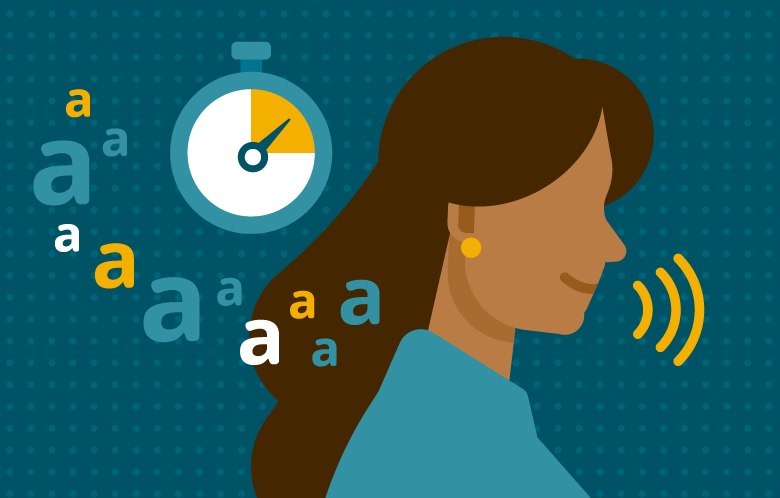Imagine you are starting your first meeting of the day. You attempt to greet your colleagues but cannot produce a sound — all you can muster is a guttural “ahem”, the initial throat clear you use to jump start your voice. By the end of the day, your voice is tired from projecting through a mask or screen. Like many people, you are most likely experiencing vocal fatigue, a condition caused by overuse leading to tiredness, aching, tightness, or reduced vocal function. (Kang et al., 2020) Vocal fatigue can lead to voice disorders which are estimated to be present in 20 percent to 50 percent of occupational voice users. (Kang et al., 2020).
Vocal fatigue is bothersome, but preventable. Maintaining good vocal hygiene and completing a vocal warm-up can facilitate improved voicing while minimizing vocal effort.
Get Your Voice Ready
Staying hydrated is a helpful first step in taking care of your voice. Adequate hydration (64 ounces of water a day or half your body weight in ounces) can lead to less air pressure and less effort needed for voicing. (Waldon & Isetti, 2019) Try to avoid activities that can be traumatic to your voice, such as shouting across the room, straining to talk over background noise, frequent throat clearing, or prolonged yelling. Reduce or eliminate use of alcohol, caffeine and smoking, which can lead to throat irritation.
Get Set
Vocal warm-ups, such as straw phonation exercises, improve voicing by reducing exertion and fatigue. Phonating (voicing) through a straw enhances airflow pressures within the airway and eases stress on the vocal folds: (Manjuantha et al., 2020)
- Press your lips around a three mm diameter straw (think coffee stirrer) and keep a tight seal. Avoid air leakage around the straw and air escape through the nose.
- Produce and sustain the vowel /a/ into the straw at a normal pitch and volume. Phonate (turn your voice on) for 15 seconds and rest five seconds. Repeat three times.
- Glide your voice from a comfortable low pitch to high pitch and comfortable high pitch to low pitch through the straw. Phonate 15 seconds and rest five seconds. Repeat three times.
If you are achieving good forward focus, you will feel vibrations in your face and mouth. A standard straw (approximately five mm) can also be used (Kang et al., 2020) as an alternative method.
Go
After your vocal warm-up, begin to speak. Reflect on how your upper body, throat and mouth are feeling as you communicate. Voicing should feel relaxed without strain. Consider using straw phonation exercises throughout the day and prior to vocally demanding tasks, such as presentations or long meetings, to prevent vocal fatigue. (Kang et al., 2020) Additionally, you can implement these exercises after periods of vocal exertion to assist in vocal recovery. (Fujiki et al., 2021)
Red flag: If you experience persistent changes in your voice for greater than two weeks, seek assessment from a laryngologist or an otolaryngologist. (Waldon & Isetti, 2019) They can determine etiology and assess for contributing factors to your voice problems such as reflux, sinus drainage, or structural changes. A referral to a speech-language pathologist may be beneficial for additional assessment and exploration of other useful voice therapy techniques.
To find the latest evidence and decision support information for optimal patient care, turn to Dynamic Health™. Dynamic Health is an evidence-based tool designed to help nurses and allied health professionals master skills, obtain fast answers to questions, and foster a culture of evidence-based practice and critical thinking leading to improved patient outcomes.
References
Kang J, Xue C, Lou Z, Scholp A, Zhang Y, Jiang JJ. The therapeutic effects of straw phonation on vocal fatigue. Laryngoscope. 2020;130(11):E674-E679. https://doi.org/10.1002/lary.28498
Waldon EG, & Isetti D. Voice disorders and related risk factors among music therapists: Survey findings and strategies for voice care. Music Therapy Perspectives. 2019;37(1):37-44. https://doi.org/10.1093/mtp/miy010
Manjunatha U, Nayak PS, Bhat JS. Can straw phonation be considered as vocal warm up among speech language pathologists? J Voice. 2020;S0892-1997(20)30304-0. https://doi.org/10.1016/j.jvoice.2020.08.016
Fujiki RB, Huber JE, Sivasankar MP. Mitigating the effects of acute vocal exertion in individuals with vocal fatigue. Laryngoscope. 2021;131(12):2732-2739. https://doi.org/10.1002/lary.29627



